Period:
SFR Yugoslavia
Region:
Bosnia and Herzegovina
The Bosnian Muslims camp "Viktor Bubanj" in Sarajevo 1992
The Camp Viktor Bubanj or “Ramiz Salčin” is a former notorious camp in the system of Muslim concentration camps in Sarajevo (later called “Ramiz Salčin”) for the torture and killing of Serbs (civilians and soldiers). This prison was established by the Muslim paramilitary formations in May 1992 in Sarajevo, immediately after the Yugoslav National Army moved away, as their barrack had been here for decades. As soon as JNA soldiers left, Alija’s soldiers moved in.
The Muslim civilian and paramilitary authorities in Bosnia and Herzegovina were well aware of the camp’s existence and what was going on inside it, but they failed to do anything to stop the torturing of Serbs and the terrors conducted by the guards.
The Camp Viktor Bubanj was one in the system of 126 camps in which Serbs were imprisoned during 1992-1996 in Sarajevo.
Around 5,000 Serbs of all ages and both genders passed through the camp, while several hundred were killed for the three and a half years of the Bosnian war. Only 10% of inmates were JNA soldiers, later members of VRS (The Army of the Republic of Srpska), while the rest were Serbian civilians. Those were mainly Serbs from the Sarajevo area that were brought into this dungeon, but also from other areas around, even from the valley of Neretva.
For a long time, Muslim authorities were successfully hiding this camp from international commissions that were coming to Bosnia and Herzegovina during 1992-1995, but one delegation of MCK managed to find out about the camp in February 1993 and create a list of inmates.
The Hague tribunal did not want to persecute the criminals of this camp even though they received an excessive amount of documentation from the Prosecutor of the Serbian Republic in B&H.
A very small number of torturers from this camp were brought before the judge in Bosnia and Herzegovina because the prosecution of B&H purposely obstructed this case in order to hide the involvement of Muslim leaders and the chain of command in Sarajevo during the war.
This camp was given the nickname “Juka’s prison” based on its warden Yusuf Prazini aka Yuka, and whom the Muslim Presidency of B&H appointed as a commander of the military special forces.
BACKGROUND
SFR Yugoslavia was a federal state made up of 6 republics (FR Slovenia, FR Croatia, SR Bosnia, and Herzegovina, SR Montenegro, SR Serbia, and SR Macedonia). Both Yugoslavia and the JNA were established on the principle of “brotherhood and unity” of all peoples and nationalities who lived in the SFRY.
The social and economic system of the SFRY was socialism.
The 1974 Constitution of Yugoslavia brought about the decentralization of the SFRY, which later enabled the separatist forces in Slovenia and Croatia, and later in Bosnia and Herzegovina to begin the dissolution of Yugoslavia, followed by bloody wars and persecution.
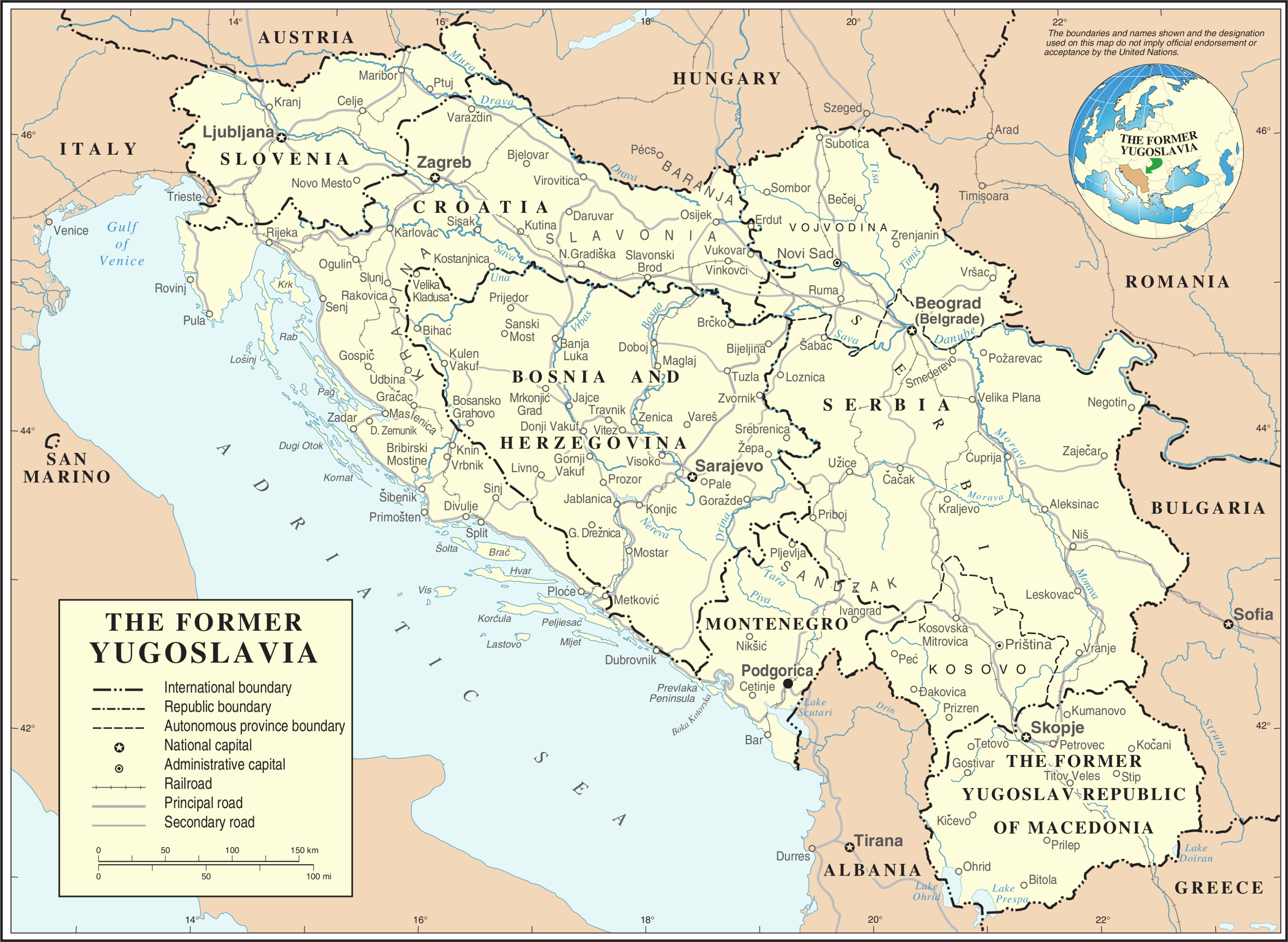
In all the constitutions of Yugoslavia, the Yugoslav People's Army was defined as the only legitimate armed force in the territory of the SFRY, and therefore, the only internationally recognized military entity. At the end of 1989, the SFRY Assembly passed amendments to the Constitution, thus replacing the one-party system with the multiparty system, which meant that besides the Alliance of Communists of Yugoslavia, other parties could now be formed.
At the end of January 1990, the Alliance of Communists of Yugoslavia collapsed, at the 14th SKY Congress in Belgrade, when sharp verbal clashes between Slovenian and Serbian delegates occurred regarding the future of the joint state of the SFRY.
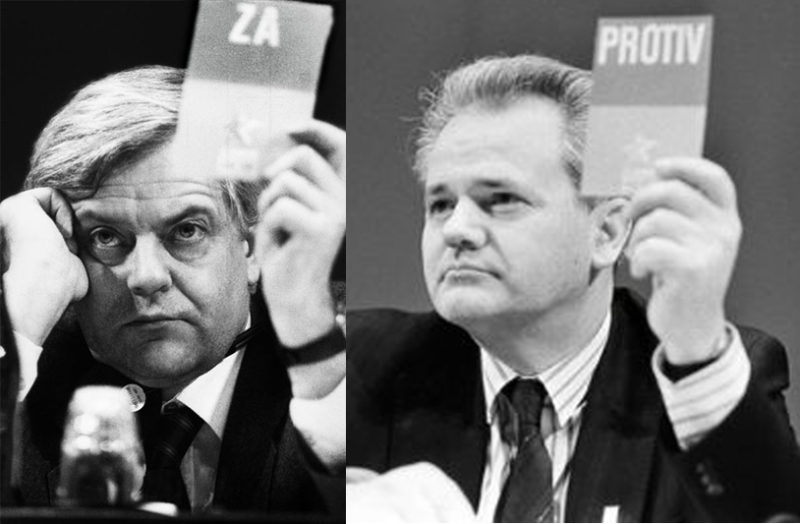
Opposing sides - Kučan and Milosević
The Slovenian delegation left the session, immediately followed by the delegation of the FR Croatia, which brought the issue of the congress into question. After them, the delegations of the FR of Bosnia and Herzegovina and the FR of Macedonia also left the congress.
Thus, after 45 years, the rule of the communists in SFRY ended.
The situation in Bosnia and Herzegovina
Bosnia and Herzegovina has been a central republic within the Socialistic Federal Republic of Yugoslavia, where Muslims, Serbs, Croats, and national minorities lived. On 18 November 1990, a multiparty election took place, the first after World War 2. The government was formed by the anti-communist parties- SDA, SDS, and HDZ. MP that won the highest number of votes (47,4%) was Muslim Fikret Abdić, a businessman from Velika Kladuša.
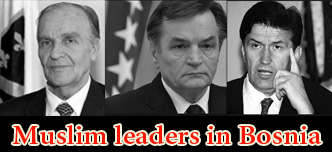
Alija Izetbegović, Ejup Ganić, and Haris Silajdžić
However, he was under pressure by Muslim extremists to step aside since he was against the war and conflicts with Serbs. As it turned out, he only served as bait for Muslim voters.
Alija Izetbegović, a pre-war criminal and author of the notorious chauvinistic “Islamic Declaration” became president of the presidency of B&H. Momčilo Krajišnik, a member of the Serbian party (SDS) became president of the Parliament, while a Croat Jure Prelivan was appointed to the prime minister of the Federal Republic of Bosnia and Herzegovina. The coalition ruled for 15 months. It collapsed at the beginning of the conflicts in Bosnia in April 1992.
Leaders of Muslim Party of Democratic Action- Alija Izetbegović, Ejup Ganić, Haris Silajdžić, and others, advocated the independence of Bosnia and Herzegovina from Yugoslavia as early as 1991. Muslim SDA and Croatian HDZ shared a goal of an ethnically and religiously cleansed state. However, Bosnian Croats wanted integration with Croatia, while Muslims wanted to create an Islamic state.

Izetbegović participated in WW II in notorious Bosnian Muslim 13th Waffen
Mountain Division of the SS Handschar (1st Croatian) member,
known for the WW II genocide of Serbs
The Bosnian independence propaganda was spread by the media and press. As early as October 1991, the press in Sarajevo published open threats directed towards Serbian people. Among everything else, it was announced that the notorious Hadschar Division, Ustasha unit that committed horrible crimes against Serbs in the Independent State of Croatia (NDH) during 1941-1944, would be re-established. This unit had been mostly filled with Muslims. Ustasha crimes in NDH reached their peak in Bosnia itself with Prebilovci, Drakulić, Bileća, Gacko, Donja Gradina, Kupres as the most suffering places.
August 1995 witnessed organized arming of paramilitary forces of Muslims and Croats in Bosnia and Herzegovina through channels of the parties SDA and HDZ, intending to attack the Yugoslav People's Army (JNA). In October 1991, local committees of paramilitary units "Green Berets" and "Patriotic League" were established. In the second half of 1991, Mostar was full of members of the JNA, who came from Croatia (Dalmatia and Dubrovnik area), from where they were expelled or withdrawn. They further withdrew in Užice (Serbia) at the end of March 1992.
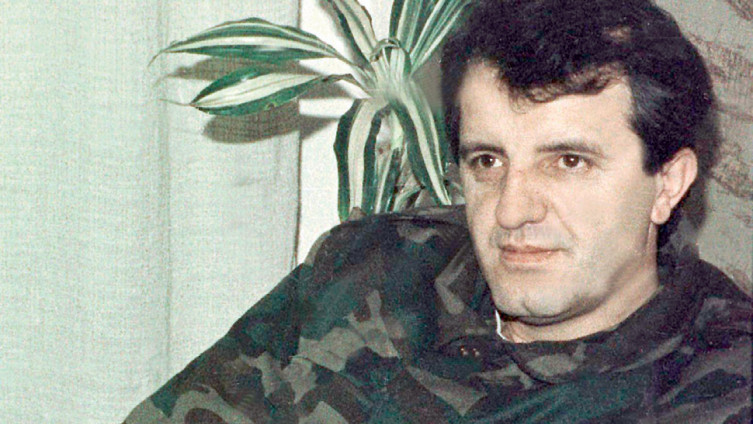
Sefer Halilović - founder of Bosnian Muslim paramilitary forces
On March 1, 1992 a referendum on the separation of Bosnia and Herzegovina from Yugoslavia was organized with 62.4% of voters having voted for independence. A day later in Sarajevo, members of the "Green Berets", led by a criminal Ramiz Delalić aka Ćelo started shoting at a Serbian wedding party at Baščaršija having killed the groom's father Nikola Gardović and wounded priest Radenko Miković.
This was an event that announced the bloody war in Bosnia-Herzegovina in the 1990s, but this also served as cause to dissolve still nationally-mixed police in Sarajevo. After that, numerous attacks on Serbian positions in Bosnia and Herzegovina and on members of the JNA occured (Sijekovac, Kupres, Sarajevo, Tuzla...). International representatives remained silent to these events.
THE SITUATION IN SARAJEVO
Sarajevo is located in the central part of Bosnia and Herzegovina and occupies an area of 142 km2. It is located in the composite Sarajevo valley, which spreads from east to west of fertile Sarajevo fields. The oldest parts of the city (Vratnik, Bistrik, Hrid, Kovači, Alifkovac) lie on the slopes of the surrounding hills. The average height above sea level is 500 meters. The city is surrounded by high mountains that reach 2000 meters above sea level: Bjelašnica, Jahorina, Igman, Treskavica, and Trebević, which are mostly cold throughout the year and covered in snow.

Sarajevo has cultural traces from prehistoric ages. Later, Illyrians, Celts, Romans inhabited these areas, while Southern Slavs arrived in the Balkans in the 6th century. In the time of the Nemanjić dynasty, Bosnia was an integral part of the medieval Serbian state, and its rulers built Orthodox temples. Bosnian king Tvrtko I Kotromanić raised Bosnia to the level of a kingdom and was crowned in the monastery of Mileševa in 1377.
With the invasion of the Balkan Peninsula by Osmanli Turks, all Christian states perished, and Turks started to bring Islamic religion to these areas and build mosques. Their bloody conquests went as far as Vienna, where they were defeated in 1683. After that defeat, their two-decade retreat towards Asia started. In Bosnia, the Osmanli Turks reigned in terror for over 400 years (Blood tax, The First wedding night, Turkification, Third of the Harvest and etc.), so the Serbian people often rebelled (Nevesinje rifle, etc).
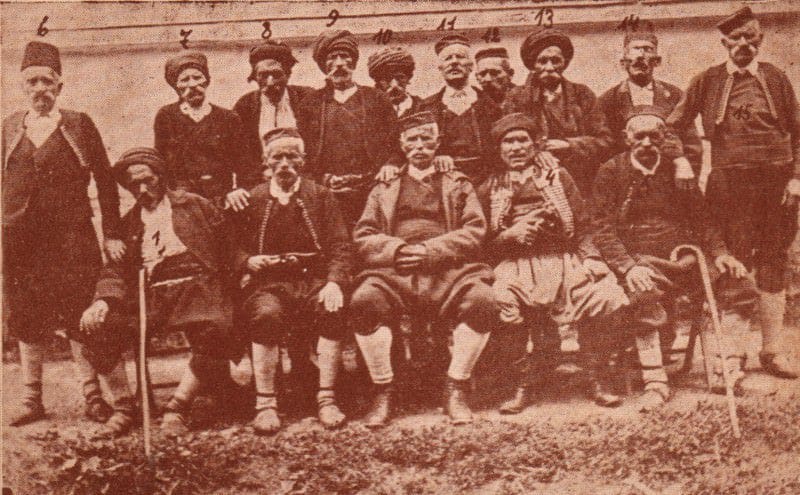
At the Berlin Congress in 1878, great powers allowed Austria to occupy Bosnia and Herzegovina, and thirty years later it annexed this country, which caused the Annexation crisis with the Kingdom of Serbia. The Royal Palace of Vienna continued to impose terror upon the Serbs which resulted in anger and the creating of the revolutionary organization Young Bosnia, which carried out, on Vidovdan 1914, an assassination of the Austrian Prince Franc Ferdinand right in the town of Sarajevo. This served as a Casus Belli for the Austro-Hungarian monarchy to attack Serbia and start the First World War.
With the liberation of the Kingdom of Serbia and all Serbian states in late 1918, the first Yugoslav nation was created: Kingdom of Serbs, Croats, and Slovenes, while Sarajevo became a part of what was then Drinska Banovina.
Serbs were a majority in Sarajevo for many centuries, the city had a population of around 100,000 before World War 2, of which 60% of the population was Serbian.

During World War 2, Sarajevo was a part of the Independent State of Croatia, where Ustashas committed horrible crimes upon Serbs, Jews, and Roma. The city was literally halved. Many residents of Sarajevo were taken towards Jasenovac and tortured to death. Rare were those who survived this hell.

The partisan units of NOBJ entered the city only on 6th April 1945, and after many weeks of heavy fighting, they managed to liberate the city. New communist authorities after the war did not allow the talks about Serbian deaths and even persecuted prominent Serbs. They used to attribute Croatian war crimes to Germans- all for preserving the brotherhood and unity.
Under socialism, Sarajevo saw a tremendous expansion and growth, it became an appealing place for the young, and the number of citizens greatly increased, together with residents of rural areas of Bosnia and Herzegovina. In the 1970s, Sarajevo became the city of the future in Europe. In 1984, it became a host of the Winter Olympics.

In the second half of the 1980s, many Muslims from the Raška area started to inhabit Sarajevo, which is when Serbs in Sarajevo began to lose the relative majority.
ESTABLISHMENT
The camp “Viktor Bubanj was established in former JNA barracks on 21st June 1992, when first inmates were brought in. Most of them were civilians, who were transferred from the Central prison in Sarajevo, where there were no more rooms for all the Serbs that were being brought in there.
The Muslim paramilitary forces established this camp under the instructions from the head of Muslim authorities in Sarajevo and immediately the camp was renamed “Ramiz Salčin ''.
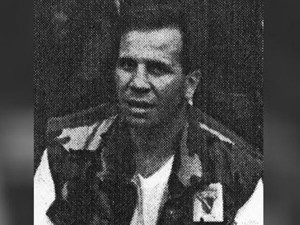
The story behind the name of the camp was the death of a Muslim sniper, Ramiz Salčin, in Sarajevo settlement Nedarevići on 22nd August 1992, who was posthumously awarded the Golden Lily. Until 1991, Salčin was an alcoholic, gambler, and brawler who had a bar made of sheet metal. He was born in Herzegovina, in the vicinity of Gacko on 13th May 1954, and came to Sarajevo in the 1980s.
Serbian civilians were being brought here under false accusations of hiding weapons, giving “Chetniks” their locations, dodging military service, being party members of SDS, allegedly molesting Muslim women, and for the escape attempts to the liberated Serbian territory and similar. Soldiers had no trials, while civilians did. Sentences were from 10 years to a death sentence.
In camp “Viktor Bubanj” the District military court and District Military Persecution were placed under the command of the 101st Muslim battalion of the so-called “Army of Bosnia”.
NAMES OF VISITORS
Camp “Viktor Bubanj”, that is “Ramiz Salčin” according to witnesses’ testimonies, was often visited by the highest authorities of civil, police, and paramilitary structures in Bosnia and Herzegovina. Among them were:
- Alija Izetbegović, president of the Muslim Presidency of B&H, and war leader of Muslims during the war.
- Ejup Ganić, deputy of Alija Izetbegović, member of the Muslim Presidency of B&H
- Mustafa Cerić, member of the so-called Muslim Academy of Science and Art
- Rasim Delić, head of the department for planning and training of Muslim troops in B&H
- Sefer Halilović, Head of General Staff of Muslim Army of B&H
- Dragan Vikić, commander of Muslim special forces in Bosnia and Herzegovina
- Ismet Bajramović Ćelo, commander of the military police of the Muslim army
- Bakir Izetbegović, member of Muslim Presidency of B&H
- Bakir Alispahić, Minister of Interior in the Muslim Government of B&H
THE CAMP STRUCTURE
The Camp “Viktor Bubanj” in Sarajevo had 19 cells in total, of which 12 were for men and 7 for women.
There was a separate cell for delegations of news reporters and the International Red Cross to show them that everything was in order and that the law was strictly followed.
In reality, all those monstrous horrors were hidden.
NAMES OF TORTURERS
COMMANDERS:
- Besim Muzderović, warden 1992-1993
- Himzo Dolan, warden 1993-1995
- Ramiz Avdović, commander of the camp guard
- Zlatan Crnković, military policemen of the so-called Muslim Army of B&H
- Ćazim Skalonić, deputy of Juka Prazina, who usually conducted arrests of Serbs around Sarajevo.

BEATERS
- Daut Kemo, military police, guard of the camp
- Davor Matić, military police
- A person with the nickname “Sale”, guard
- Samir Mihajlović,
- Mirsad Potur,
- A person with the nickname “Pipica”.
- A person with the nickname “Dujo”,
- A person with the nickname “Šaphauz”,
- Meho Sobo, especially stood out in the beatings
NAMES OF THE VICTIMS
SURVIVED:
- Branislav Dukić, imprisoned for 2 months during 1994
- Strahinja Živak, imprisoned for 33 months during 1992-1994
- Sretko Damjanović, from Vogošća
- Nada Tomić, from Vogošća
- Borislav Herak
- Dobrila Ljuboja, spent 29 days in the camp.
- Daviola Dzepina, wife of a JNA officer
- Saveta Ninković, wife of a JNA officer
- Vida Babić, wife of a JNA officer
- Senila Brakuš (born 1916)
- Ilinka Rajić (born 1918)
- Radenka Odžaković (born in 1970), a mentally retarded person, came wounded.
- Ranko Skoko
- Miloradka Plavšić
- Ana Štrbac,
- Kostadin Ristić
- Vladimir Janković, JNA colonel
- Miroslav Savić,
- Zdravko Kekić,
- Goran Smiljković,
- Radoja Marinković
- Vukasin Terzić.
- Drago Škrba,
- Goran Ogić,
- Dragoljub Mihajlović,
- Ratka Erić,
- Slobodan Damjanović,
- Milka Lonco,
- Duško Kljajić,
- Rade Marinković,
- Branko Žiovković,
- Sreten Đerković,
- Zdravko Kuljanin,
- Mile Đerić,
- Radovan Skoko,
- Milivoje Skoko,
- Miloš Jokić,
- Mile Rodić,
- Pero Jeremić,
- Ostoja Bojić,
- Radovan Miočević,
- Stojan Ćebo,
- Budo Knezević
- Goran Knežević,
- Saša Trninić
- Jovica Trninić
- Nebojsa Savić
- Romko Petrešin
- Slobodan Gutalj
- Ljubomir Drakula

Strahinja Živak- witness and victim
MURDERED:
- Milorad Gligorović, from Ilidža, professor of mathematics
- Trivo Guslov
- Novica Ničević
- Bracanović, JNA colonel
- Aleksandar Matić
- Stevo Šiljegović
- Dragan Zelić, hanged in the camp.
- Uros Rkanović, died of beatings
- Zoran Odzaković, died of starvation and beatings
- Petar Kuzmanović, died of starvation and beatings
- Ostoja Šoja, killed.
- Pero Pjevac, killed and buried in the "Lav" cemetery near the hospital
- Mato Djeranić, disappeared from the camp, presumed to have been killed
- Radoje Marinković, disappeared from the camp, presumed to have been killed
- Slobodan Matović, disappeared from the camp, presumed to have been killed
- Slavka Damjanović, disappeared from the camp
- Mihajlo Radojičić, disappeared from the camp
- Nedeljko Živković, missing ...
- Stevo Raković, missing ...
- Pero Pikulić, missing ...
- Vojko Radovic, missing ...
- Vojin Vukadin, missing ...
- Slavko Turnjanin, missing ...
- Čajević, missing ...
- Đuro Jeličić, retired police officer, missing..
- Savo Krstović, stabbed with knives
- Veljko Odzaković, died of cold and beatings
- Ranko Dulić, crucified, forced to drink a glass of his blood
- Nedeljko Odzaković, died of pneumonia
- Milan Nišić, killed
- Janko Sikma, killed 4 days after arriving at the camp from beatings
THE CAMP CONDITIONS
Conditions in the Viktor Bubanj Muslim camp in Sarajevo were extremely inhumane contrary to all international conventions. Prisoners were often exposed to starvation. They were given food twice a day consisting of a rare soup and a slice of bread. They often injected chemical substances (dishwashing detergent) into their food, which caused many prisoners to develop diarrhea and die of exhaustion. Some inmates had to steal food from dogs when they went outside.
The camp cells were mostly 2 x 3 meters and housed 12-15 prisoners.
The prisoners did not have beds but were laying on the floor. They had no heating, hence many inmates were exhausted from the cold when the temperature in the winter nights dropped to minus 25'C. Some prisoners found the clothes of JNA soldiers since the barracks of the Federal Army of the SFRY was there until May 1992. They put those clothes on themselves which served for the camp managers to present them as "Chetniks", prisoners of war, and not civilians, to the Muslim media.
Prisoners were not allowed to use the bathroom or anything like that. They didn't have the right to wash their faces more than once in 2 weeks.
On the Day of Saint Sava, 27th January 1993, after a great cold, the warden of the prison, Himzo Dolan took all Serb prisoners out into the yard and asked them to take off their shirts. They stood half-naked for about half an hour at a temperature of minus 20'C. On that occasion, he told them that it was good for them and that they should take some fresh air.
The detainees were brought to hear long prison terms verdicts based on false accusations. When the "convicts" did not want to sign them, they were severely beaten. Many prisoners lost 30-40 kg of body weight during the imprisonment in the camp. They didn't have proper health care. They were dying of jaundice, pneumonia, dysentery, etc. The detainees were watered with cold water and left on cold.
Torturers often took prisoners to fake shootings and shot them over the head.
Serbian women were regularly raped several times, many remained pregnant, and were offered to abort if they signed statements that they were raped by Serbs.
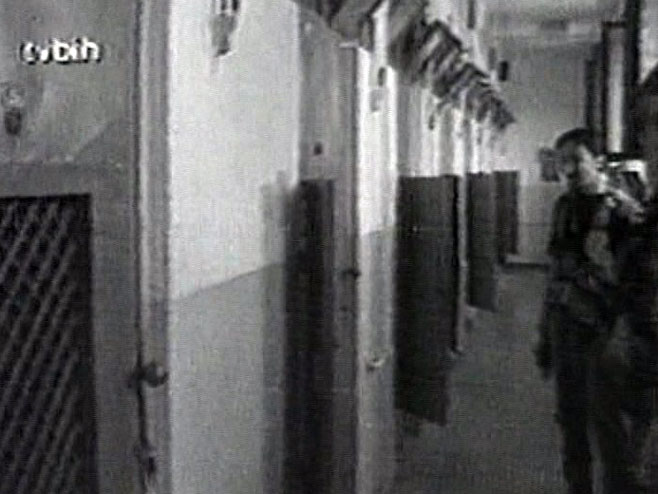
WITNESSES
Strahinja Živak (1932-2014), one of the detainees in this camp, said the following:
"I was taken from a hospital bed in April 1992 to Sarajevo Central prison for four days, and then I was deported to "Viktor Bubanj", where I was under investigation for eight months. After strong interrogations, on the basis of a forced statement, without witnesses, without arguments, allegedly to their information, they imputed that I, as the vice-president of the local board of the SDS used my influence to divide B&H and create a separate state.
My trial was scheduled after eight months of investigation where I had lied on the floor, where there were 16 people in 6 m2 with open wounds, without health care, while during the trial, I had no legal protection. I was sentenced to 15 years of prison.
There were also women in prison. Through the bars, I saw 33 women that were taken for a walk.
There were also pregnant women. There were whole families. One retarded girl was terribly harassed and accused of being a sniper. Muslim police officers drank in the evening and after 10 pm they took the women away and raped them. They were talking about what each of them was like in those ‘things’ ...
We ate a crust of bread a day, and a special "treat" from chef Julian Ventil was to give the detainees water with dishwashing detergent, due to which they regularly received diarrhea.
In prison, I received a letter from my brother who told me that Muslim-Croat forces killed my sons Slobodan and Velimir in Bradina on 26th May 1992. I was exchanged on 9 November 1994 ...".
Sretko Damjanović, one of the detainees in the camp, said the following:
"With Borislav Herk and Nada Tomić, I wandered from Vogošća to the territory under the control of the Muslim army in 1992 ...
They took us to the Viktor Bubanj camp, and Ramiz Avdović was there. He came to my cell and rdered me and Nada Tomić to raise our hands against the wall, beating us on our kidneys. Ramiz Avdović and warden Himzo Dolan knew what was happening in those barracks.
Beatings lasted for fourteen days during which they tried to pursued me to confess that I had committed crimes. A lot of them were involved in beating, so I couldn't move from all the pain. I was visited by Fahrija Karkin, Senad Kreho, and others. They were trying to extort my confession for non-existent war crimes.
I came out of the camp as a severely disabled ... ".
Dobrila Ljuboja, who spent the hardest 29 days in this Sarajevo hell.
- "Twenty-nine long days, spent in the rooms of this torture chamber that also ruined my life. Even today, I am often awakened by the screams and cries of the innocent and helpless people who, just because they are Serbs, have gone through all kinds of humiliation ...
I was arrested on the streets of Sarajevo in May 1992, when I went to the store to buy some groceries and was immediately taken to the camp. Edin Milišić intercepted me on the street and told me that I should go to the police and give a statement about my son Veselin.
I didn't even get to the police. I was taken straight to the Viktor Bubanj camp, and Edin was a friend of my husband Vesko until the war.
During the investigation, I was accused because my people from Pale hill killed innocent Muslims. I and other detainees were charged with such nebulous accusations, and there were more than fifty of us in one room. There were also minors who were raped and beaten by guards, and as such returned to their cells covered in blood. Worse than beatings was the humiliation. And they beat us every day with anything they could find- guns, clogs, baseball bats, and even a rough wooden plank, almost 10 centimeters thick. Now, I, who spent less than a month in Viktor Bubnj’, spend more money on drugs, than on bread. My kidneys suffered terribly damage.
After 29 days, I and 14 other girls were taken by van to the hotel "Zagreb", which was a kind of brothel where Serb detainees were raped. I was lucky that on my way to Marindvor, I was pulled out of the van by my son’s friend, who today lives abroad and whose name I will not say publicly as long as I live. He put me in the car and transferred me to Dr. Stjepan Stup, who invited our priest Moma to Blažuj.
He organized my extraction to Serbian territory. I couldn't believe I was free. My uncle Milan Nišić was taken out of his flat and was also detained in the camp apartment. They watered him with a water hose. When he got a fever, he was taken to the hospital ‘Koševo’ and every trace of him was lost there ... ".
A protected witness, a Serb woman born in Sarajevo in 1972, made the following statement:
"In May 1992, I was arrested in my family apartment in Sarajevo and brought to camp Viktor Bubanj.
Vesna Subotić was brought to the camp in 1992, and when a Muslim soldier tried to rape her, she smashed a glass bottle of water and with the debris stabbed him in the back. He bled to death, and she was killed by three bullets from a pistol fired into her chest. I saw it clearly because all of this happened in our cell.
I and five other young Serb women were constantly raped in the camp. In this torture, about 20 Muslim soldiers took part. There, in front of camp inmates, at the beginning of September in 1992, four captured Serb soldiers were shot dead. We were subjected to a fake shooting. They would shoot over our heads, and then they would put us back to our cells with the ‘promise’ that they will kill us tomorrow.
When I became pregnant, the camp commander asked me to sign a statement that Serbs raped me, and they would allow me to have an abortion. But I didn’t dare to do that, because I heard that a girl had agreed earlier and that she was allegedly taken to the ‘Jezero’ clinic from where she did not return ... ".
Romko Petrešin, a detainee of the Viktor Bubanj casemate, told to RS investigators:
- "I was sentenced to 10 years in prison, and survived eight trials ". A lawyer appointed to me was mostly silent. After two years of unseen torment, I was "released" because nothing had been proven. I was released in the city of Sarajevo without any documents. That meant they could arrest me again or kill me immediately.
I made an escape plan with two other Serbs. At the cost of life, we decided to escape from the Muslim part of the city because an obstacle to freedom was, among other things, double minefields. Our escape succeeded and we reached Serbian land ... ".
PUBLICATIONS
Former detainees, who managed to survive the horrific torture wrote books. Strahinja Živak has written several books about his days of imprisonment in three Muslim camps. One of the books is called "I live to testify".
Marko Mikerević was forcibly mobilized as a lay judge, and in November 2004, he published the book "Sarajevo Cauldrons of Death" in which he described what was happening in the Viktor Bubanj camp, as well as who, among Muslim leaders and commanders visited the camp.
TRIALS AND INDICTMENTS
The Prosecutor's Office of Bosnia and Herzegovina has initiated court proceedings against Senad Kreha, who was convicted of genocide, but in 1997, the trial was reinitiated and a shameful verdict was passed according to which Kreho was released because his "victims are alive". He later became a well-known lawyer in Sarajevo.
In October 2011, SIPA members arrested Ramiz Avdović and Besim Muzderović, under the accusation of torturing Serbs in the "Viktor Bubanj" camp in 1992.
On May 19, 2019, the State Court of Bosnia and Herzegovina, sentenced former beaters Ramiz Avdović, and Julijan Nikolaj Vintila to three, and two years of prison, respectively.
YEARS LATER
In 2003, former detainees tried to place a memorial plaque on the building of the former camp, which is today the building of the Court and the Prosecutor's Office of B&H, but the authorities in Sarajevo didn’t allow, but coercively prevented it.
Also, Serbs could never hold a memorial service (religious rite) on the site of the former camp. They are now allowed to conduct such things.
Tags:
Please, vote for this article:
Visited: 4299 point
Number of votes: 5
|